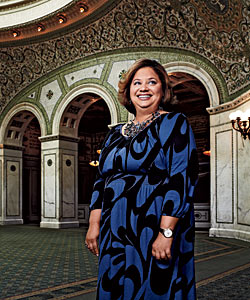Interview by Noah Isackson

Boone under the Tiffany dome in the Chicago Cultural Center
You became Chicago’s cultural commissioner in a time of turmoil. Before leaving office, Mayor Daley set in motion the merger of the Department of Cultural Affairs—traditionally responsible for the city’s arts programming—with the Mayor’s Office of Special Events. Lois Weisberg, your colorful predecessor, quit and blasted the merger [which resulted in 29 layoffs and a 19 percent decrease in combined budgets]. How did it feel to replace her?
I came in with a bit of a heavy heart. I worked for Lois Weisberg [from 1998 to 2003] and was very privileged to have had that experience. I also came in knowing many of the people that this merger impacted. I had a lot of admiration for the work that they had done to make Chicago this thriving art scene. We had to roll up our sleeves and get through the hard part. We did.
Is your job to promote arts and culture or to promote arts and culture in the interest of tourism?
I think it’s all of the above.
Earlier this year you hosted town hall meetings to solicit input for the Chicago Cultural Plan 2012 [in draft form now, with the final document due in October]. What did you learn?
Arts education came up consistently. But it wasn’t coming only from the art teachers [but from] young people, parents, artists. [Also] people wanted abandoned or vacant spaces in their neighborhoods revitalized, and they were looking to artists as solutions for that.
What about the complaints from artists who say the city’s bureaucracy stifles their efforts to create new events?
We heard them loud and clear, and, yeah, it’s a problem. We want to eliminate the bureaucracy and make it easier for people to do their work. It’s in the plan.
The draft introduces a dedicated arts and culture tax. Any idea how much that tax will be or how it will be levied?
That was not my idea; that is an idea from the people. But there are lots of examples of other municipalities finding ways to have a dedicated revenue stream to support the arts, whether it’s a sin tax [generally on alcohol, tobacco, or gambling] or something else. If Chicago gets a casino, that could be a revenue stream.
Are there pockets of our cultural landscape that your boss, Rahm Emanuel, is especially interested in developing?
He’s interested in how Uptown can be transformed into an entertainment district. He is a former dancer, and he wants Chicago to be positioned as the premier destination for dance in the country.
Critics say the city never fully realized the goals from the last plan, created in 1986. How do you prevent that from happening again?
I don’t think the old plan ran out of steam; they got an incredible amount done. There were big ideas that took a long time to come to fruition: the establishment of a grants program in cultural affairs, the renovation of Navy Pier, the development of the theatre district on Randolph Street.
In an era of cost cutting, are you having to scrimp to stay within your $30 million budget?
We have a budget that is, by far, more than many other municipal arts programs. We have done really well at stretching that money. About 80 percent of the budget is directed to programming. Our programs reach more than 10 million people annually. That’s a big bang for the buck.
What do you say to those who argue that money spent on the arts should go instead to schools or police?
It’s not a question about spending on this or that. It’s about helping people recognize—and I think the plan will do this—that the arts are a tremendous stimulator for economic development. Artists have a deep history in Chicago of invading derelict spaces and making them cool; then other folks start moving in. The mayor frequently cites the transformation that Lincoln Square went through with the Old Town School of Folk Music. One cultural institution drew coffee shops, restaurants, homebuyers, and young families.
Which neighborhood could be the next cultural hub?
Bronzeville. There are a number of African American art galleries doing some really creative things.
As a former grant maker with the Joyce Foundation, do you consider yourself more of an artist or a CFO?
I’ve always said I’m not an artist but I am an arts crusader. I love this quote from Andy Warhol: “Good business is the best art.” That’s something I always keep in mind. You don’t throw away good business practices for the sake of creating art.
* * *
No Small Plan
The latest draft of the Chicago Cultural Plan—by the numbers
$300,000 = cost to produce the plan, with the bulk paid to a Canadian contractor
2 = number of new entertainment districts proposed
The plan suggests a new Museum Campus South to connect the Museum of Science and Industry with the DuSable Museum of African American History and a dedicated festival site (location unspecified) for large-scale city events.
1 = number of new staffers dedicated to helping artists navigate City Hall bureaucracy
258 = proposed initiatives in the 2012 plan (in comparison, the 1986 plan put forth 100 items)
16 = percentage of the initiatives that will cost $1 million or more a year to execute
3 = number of major new events planned
The document skimps on the details, but it introduces a Chicago River fest, a FutureFest for digital arts, and a cultural fest that will “attract world attention.”
60 = percentage of the initiatives that will launch within 18 months
$2.2 billion = estimated economic impact of Chicago arts groups in 2010
RELATED: More on the new cultural plan in our blog, The 312
Photograph: Dave Rentauskas; Hair and Makeup: Jenna Baltes; Photo Assistants: Lauren Butterfield, Jeremy Dop


